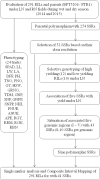A major pleiotropic QTL identified for yield components and nitrogen content in rice (Oryza sativa L.) under differential nitrogen field conditions
- PMID: 33079957
- PMCID: PMC7575116
- DOI: 10.1371/journal.pone.0240854
A major pleiotropic QTL identified for yield components and nitrogen content in rice (Oryza sativa L.) under differential nitrogen field conditions
Abstract
To identify the genomic regions for yield and NUE of rice genotypes and lines with promising yield under low N, a recombinant inbred population (RIL) developed between BPT5204 (a mega variety known for its quality) and PTB1 (variety with high NUE) was evaluated for consecutive wet and dry seasons under low nitrogen (LN) and recommended nitrogen (RN) field conditions. A set of 291 RILs were characterized for 24 traits related to leaf, agro-morphological, yield, N content and nitrogen use efficiency indices. More than 50 RILs were found promising with grain yield >10 g under LN. Parental polymorphism survey with 297 SSRs and selective genotyping revealed five genomic regions associated with yield under LN, which were further saturated with polymorphic SSRs. Thirteen promising SSRs were identified out of 144 marker trait associations under LN using single marker analysis. Composite interval mapping showed 37 QTL under LN with five pleiotropic QTL. A major stable pleiotropic (RM13201-RM13209) from PTB1 spanning 825.4 kb region associated with straw N % (SNP) in both treatments across seasons and yield and yield related traits in WS appears to be promising for the MAS. Another major QTL (RM13181-RM13201) was found to be associated with only relative trait parameters of biomass, grain and grain nitrogen. These two major pleiotropic QTL (RM13201-RM13209 and RM13181-RM13201) on chromosome 2 were characterized for their positive allele effect and could be deployed for the development of rice varieties with NUE.
Conflict of interest statement
The authors have declared that no competing interests exist.
Figures



Similar articles
-
QTL analysis of novel genomic regions associated with yield and yield related traits in new plant type based recombinant inbred lines of rice (Oryza sativa L.).BMC Plant Biol. 2012 Aug 9;12:137. doi: 10.1186/1471-2229-12-137. BMC Plant Biol. 2012. PMID: 22876968 Free PMC article.
-
Association mapping and genetic dissection of nitrogen use efficiency-related traits in rice (Oryza sativa L.).Funct Integr Genomics. 2016 May;16(3):323-33. doi: 10.1007/s10142-016-0486-z. Epub 2016 Feb 27. Funct Integr Genomics. 2016. PMID: 26922174
-
Enhanced Expression of QTL qLL9/DEP1 Facilitates the Improvement of Leaf Morphology and Grain Yield in Rice.Int J Mol Sci. 2019 Feb 17;20(4):866. doi: 10.3390/ijms20040866. Int J Mol Sci. 2019. PMID: 30781568 Free PMC article.
-
Molecular Regulatory Networks for Improving Nitrogen Use Efficiency in Rice.Int J Mol Sci. 2021 Aug 21;22(16):9040. doi: 10.3390/ijms22169040. Int J Mol Sci. 2021. PMID: 34445746 Free PMC article. Review.
-
Molecular Genetics and Breeding for Nutrient Use Efficiency in Rice.Int J Mol Sci. 2018 Jun 14;19(6):1762. doi: 10.3390/ijms19061762. Int J Mol Sci. 2018. PMID: 29899204 Free PMC article. Review.
Cited by
-
Nitrogen deficiency tolerance conferred by introgression of a QTL derived from wild emmer into bread wheat.Theor Appl Genet. 2024 Jul 17;137(8):187. doi: 10.1007/s00122-024-04692-z. Theor Appl Genet. 2024. PMID: 39020219 Free PMC article.
-
A meta-QTL analysis highlights genomic hotspots associated with phosphorus use efficiency in rice (Oryza sativa L.).Front Plant Sci. 2023 Aug 18;14:1226297. doi: 10.3389/fpls.2023.1226297. eCollection 2023. Front Plant Sci. 2023. PMID: 37662146 Free PMC article.
-
Epistasis and pleiotropy-induced variation for plant breeding.Plant Biotechnol J. 2024 Oct;22(10):2788-2807. doi: 10.1111/pbi.14405. Epub 2024 Jun 14. Plant Biotechnol J. 2024. PMID: 38875130 Free PMC article. Review.
-
A meta-quantitative trait loci analysis identified consensus genomic regions and candidate genes associated with grain yield in rice.Front Plant Sci. 2022 Nov 16;13:1035851. doi: 10.3389/fpls.2022.1035851. eCollection 2022. Front Plant Sci. 2022. PMID: 36466247 Free PMC article.
-
Elucidating the patterns of pleiotropy and its biological relevance in maize.PLoS Genet. 2023 Mar 21;19(3):e1010664. doi: 10.1371/journal.pgen.1010664. eCollection 2023 Mar. PLoS Genet. 2023. PMID: 36943844 Free PMC article.
References
-
- Glass AD. Nitrogen use efficiency of crop plants: physiological constraints upon nitrogen absorption. Crit Rev Plant Sci. 2003. September 1;22(5): 453–470.
-
- Raun WR, Johnson GV. Improving nitrogen use efficiency for cereal production. Agron J. 1999; 91(3): 357–63.
-
- Vijayalakshmi P, Kiran TV, Rao YV, Srikanth B, Rao IS, Sailaja B, et al. Physiological approaches for increasing nitrogen use efficiency in rice. Indian J Plant Physiol. 2013. September 1; 18(3):208–22.
-
- Xia L, Zhiwei S, Lei J, Lei H, Chenggang R, Man W, et al. High/low nitrogen adapted hybrid of rice cultivars and their physiological responses. Afr J Biotechnol. 2011; 10(19): 3731–3738.
-
- Namai S, Toriyama K, Fukuta Y. Genetic variations in dry matter production and physiological nitrogen use efficiency in rice (Oryza sativa L.) varieties. Breed Sci. 2009; 59(3): 269–76.
Publication types
MeSH terms
Substances
LinkOut - more resources
Full Text Sources
Medical

